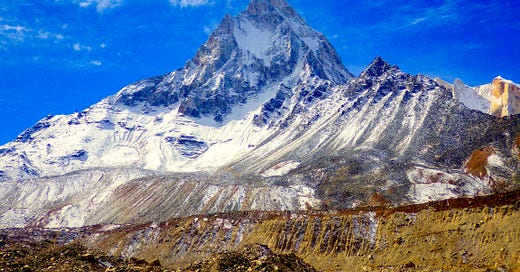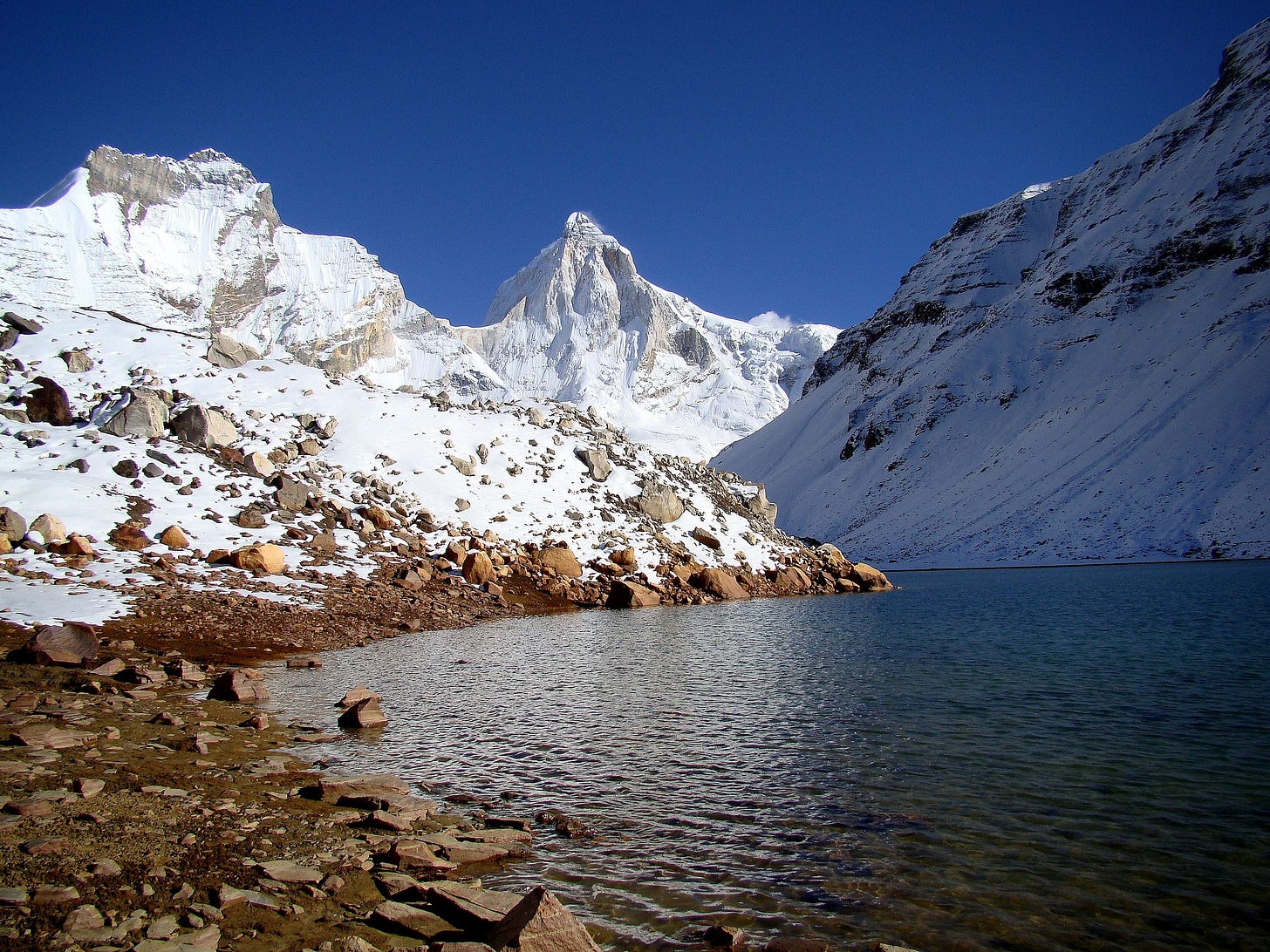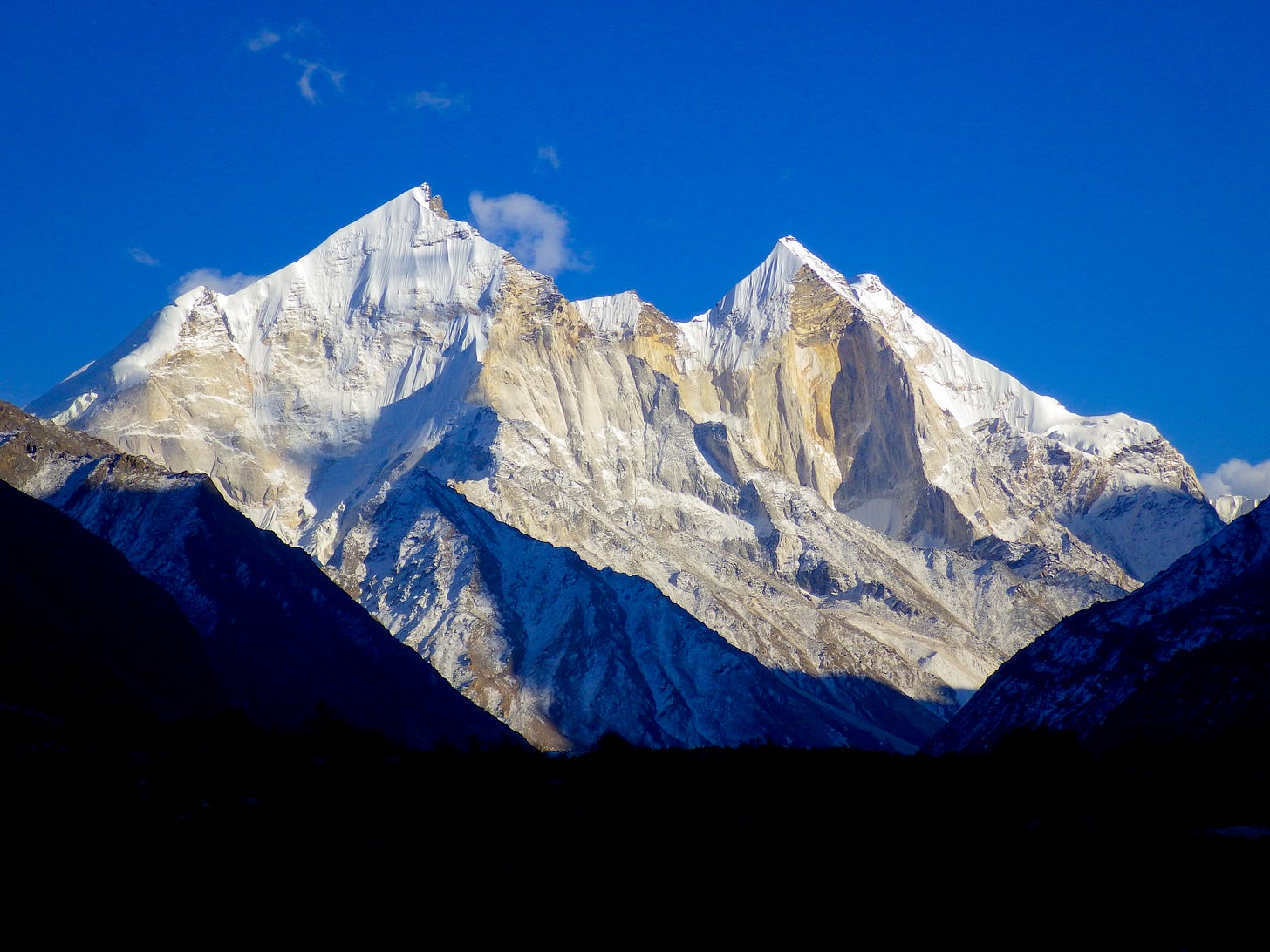#3: The Ganga Series | Part1 | The Origin of Ganga - Of mountain names and epic literature
First in a series of posts on the river Ganga, where I examine the names of peaks near the Gaumukh-Gangotri region and the story of the descent of Ganga as mentioned in traditional Indian literature.
“Why is Ganga known as the best among rivers?” This question could be asked by anyone, from any part of India. Even as we Indians worship our respective local rivers, the Ganga is different, it is revered even two thousand kilometers away from where it flows. What makes Ganga so special? You too might have wondered, I certainly did. But this is no ordinary question, it is something that even Lord Rāma wanted an answer for. The question quoted above is actually from the Rāmayana, where a curious Rāma asks his Guru Vishwāmitra for the story of the origin of Ganga.
I wanted to try and answer that question from my own perspective in a post or maybe two. However, as I went through my diary and my notes, I realised I had so much to say that this is now a three, or maybe even a four-part series on the Ganga.
My first time in the Gangotri-Gaumukh region was on my expedition to Mt.Satopanth. It wouldn’t be wrong to say that I was as excited about the hike to basecamp as I was about the climb itself. That was because the trek to Satopanth Base camp goes through Gaumukh, the source of the Ganga. Also, we trek in the shadow of some of the most dramatic-looking peaks in the Indian Himalaya - Shivling, Meru, Sudarshan and Bhagirathi to name a few.
While I was both awestruck and grateful to be standing underneath the 6500m high Mt.Shivling, the first thought when I saw the peak was that it indeed looked like the linga of Shiva. It was truly awe-inspiring to see its sharp ridges on both sides meeting at the summit with a slightly rounded edge - an imposing mass of rock, snow and ice. But who named the mountain Shivling? Who made the connection?
I had always wondered about the rationale behind naming peaks, especially in India, where most names are connected to traditional Indian literature - the Itihāsa and Purāṇas. The first Himalayan peak I climbed is called Draupadi Ka Dānda - literally Draupadi’s peak. Why was it named so? I did not have an answer. There are few mountains where visual cues can help us make sense of the names. Shivling was indeed one of them. There are a few other mountains like that but I will write about them in another post.
Why am I talking about these mountains when the post is about the Ganga? It is because I had an ‘Ahaa!’ moment when I started reading the Valmiki Rāmayana. In the very first chapter of the epic, the Bāla Kānda, there is a detailed yet dramatic description of the descent of Ganga on earth. The parallels I could find between the story narrated in Rāmayana and the naming of the peaks in the region was intriguing. How could it all be so much in sync?
The story of Ganga’s descent is found in three major texts - the Rāmayana, the Mahabhārata and the Bhāgavata Purāna. While we cannot go into the full details mentioned in these texts, let us look at the gist. Before we even go there, let us look at the peaks around the Gaumukh region. Keep in mind, it is at Gaumukh that th Ganga takes birth.
Please observe this Google earth snip carefully and remember the names of peaks.
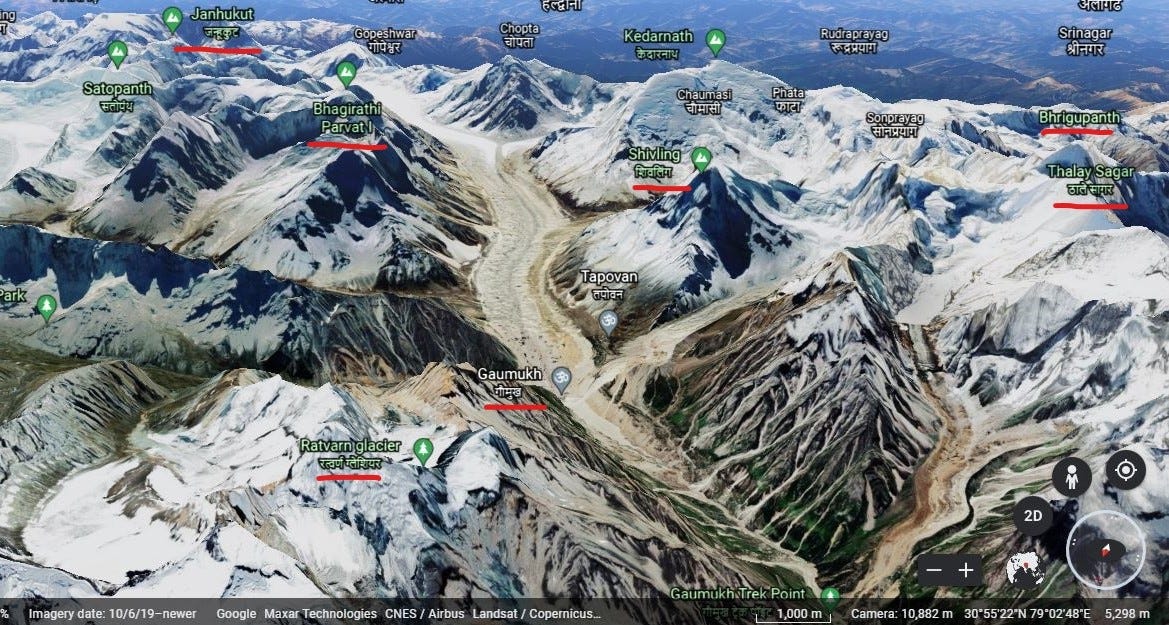
The story in the Rāmayana
As requested by Rāma, Vishwāmitra indeed gives a detailed account of the events leading up to Ganga’s descent on earth. The Ganga is the elder daughter of the king of the mountains, the Himālaya. The younger daughter is Umā or Pārvati, the wife of Lord Shiva. So Himalaya - the entire geography - is deified and is considered an individual and his daughter is the river Ganga.
The story starts with Sagara, the ancestor of Rāma, the past king of Ayodhya. He performs a penance in front of the mountain Bhriguprasravana, praying to the Sage Bhrigu for an offspring. And so we get the names of the first two mountains near Gaumukh, Thalay Sagar and Bhrigupanth (right side of the Gangotri glacier in the illustration above).
Sagara’s story is too long to be mentioned here. In short, his penance was fruitful and he was blessed with sixty thousand sons! However, later in the story all of them were burnt to ashes by Kapila, a form of Vishnu, because they falsely accused him of stealing a horse in the Nether world. Because they were burnt to death before their final rites were performed, they had to be purified by sacred water, and that could only be done by Ganga, the sacred river. But Ganga flowed only in the heavenly Ether world, the Brahmaloka, and had to be brought down. So the responsibility fell on Sagara’s great-grandson, Bhagīratha, to make it happen.
Bhagīratha, after becoming the king of Ayodhya, performed a thousand-year penance in Gaumukha. Brahma was pleased with his austerities and accepts Bhagīratha’s request for Ganga’s descent on earth to purify the ashes of his ancestors. But how could Ganga be brought to earth? Brahma says, “O Bhagiratha, the earth is incapable of withstanding the descent of Ganga, with the exception of Hara (Shiva) I do not see anyone else who can take on that burden”. So Bhagīratha had to do another penance!
This one was even harder, Bhagiratha stood on his big toe for one year, worshipping Lord Shiva. The Lord was pleased by Bhagīratha’s efforts and agreed to bear the Ganga on his head. Vishwāmitra says, “O Rāma! The eldest daughter of the Himālaya is worshipped by all three worlds. She is extremely great in form, with a force that is difficult to withstand. She descended from the sky, on Shiva’s auspicious head. She was confused by the mass of matted hair of Shiva, so she roamed around there for a number of years. Hara (Shiva) was extremely delighted at this and eventually released the Ganga”. And hence, the Ganga today starts flowing between two magnificent mountains facing each other, Bhagīrathi and Shivling.
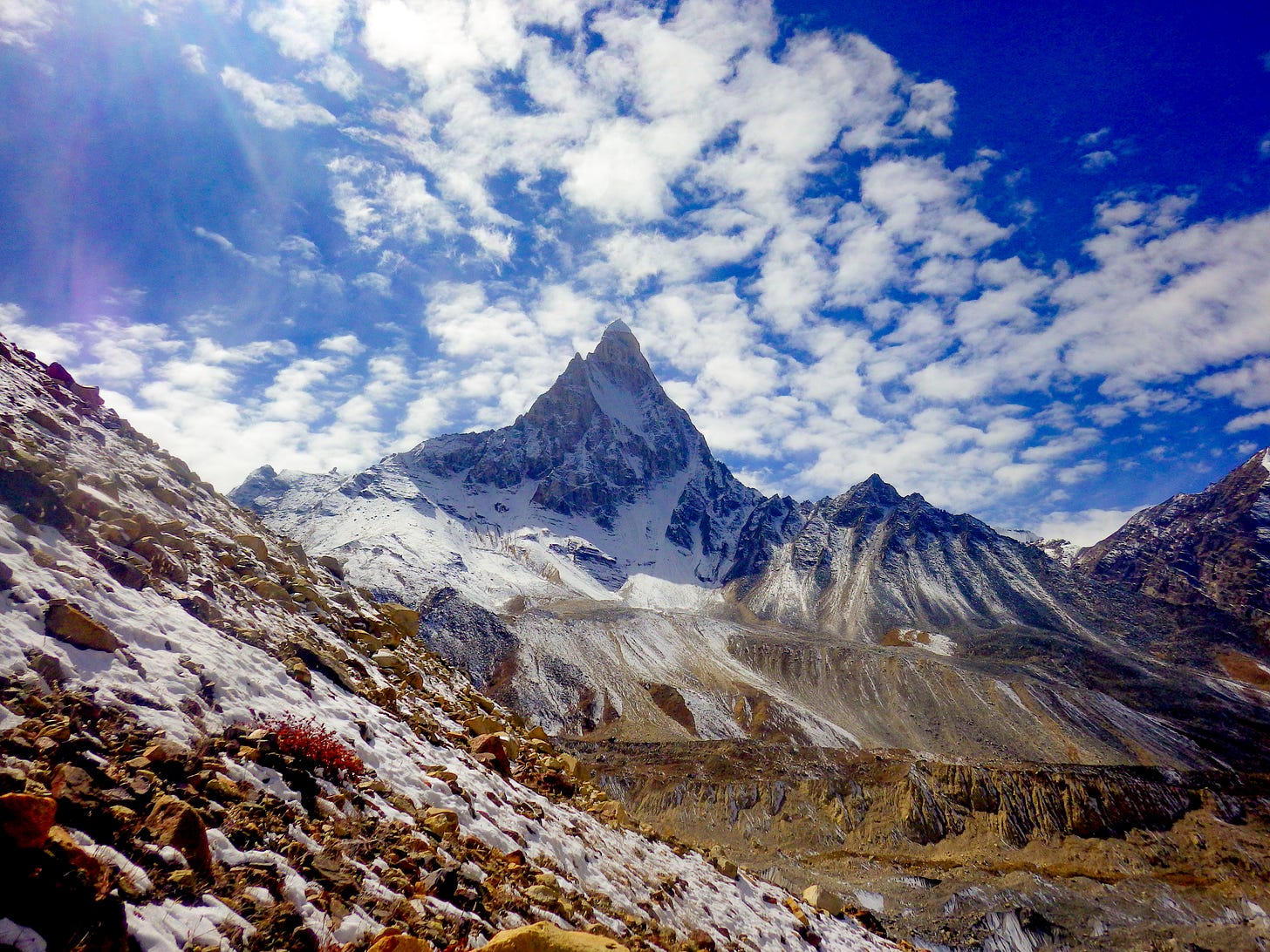
Brahma was pleased by the events and told Bhagīratha, “O king, As long as there is water in this ocean on earth, your ancestors will reside in heaven. This Ganga will be known as your daughter too. Because of your deeds, she will be famous on earth through your name”. And true to this story, today, we call the river that originates in Gaumukh as Bhagirathi and not Ganga :)
Story in the Bhāgavata Puraana
There is a precursor to the events narrated in the Ramayana and is found in the Bhāgavata. Bhagīratha indeed brought down the Ganga from the Brahmaloka but from where did Ganga come to the Brahmaloka in the first place? This is connected to the story of Vāmana avatāra (incarnation) of Lord Vishnu.
When Vishnu incarnated as Vāmana and requested King Mahabali for land that could be measured by his three steps, Mahabali proudly accepted the request. It was then that Vāmana became the giant Trivikrama - his single step extending to the very end of the Universe. But, a tiny point of his big toe-nail pierced a hole in the outer layer of the Universe which contained the holy water. Because of this, the water flowed, washing the lotus feet of Vishnu, down to the Brahmaloka. This sacred water was the Ganga. Because the water flowed through the lotus feet of Vishnu, it is said to be reddish/pinkish in colour.
So where is Vishnu near Gaumukh? He is standing diagonally opposite to Shivling with the name of Sudarshan Parvat. Sudarshana is one of the names of Vishnu mentioned in the Vishnu-Sahasra-nāma (Vishnu’s one thousand names). And the glacier on its flank even today is indeed red, hence is called by the name Raktvarn Glacier - Rakta Varna - Red coloured glacier. The water flowing out is called the Raktvarn stream and even to this day joins the glacial waters of the Gangotri glacier!
It is not over yet :)
There is another story that is connected to both the Ganga and a peak in the Gangotri region. When Ganga flowed on the earth for the first time, her torrential waters flooded the country, wreaking havoc. This disturbed the penance of Rishi Jahnu and in rage, he drank the entire water of Ganga! It was only after the Gods intervened that he let go of the water through his ears. Hence, Ganga is also known as Jahnavī. And contributing to the Gangotri glacier system is a peak called Jahnukut, a stunning 6800m peak in the far end of the glacier. Interestingly, Jahnu is married to Kaveri, the sacred river in southern India!
How could there be so much of a coincidence between the story and the mountain names? Who named these peaks and glaciers? These are questions that can never be answered. But the fact that there are so many parallels between the story and the mountain names around the Gaumukh-Gangotri region is itself astounding! Are all these stories true? We can never know because none of us can go back in time. But does it matter?
What is incredible is that we all know that the Himalayas are the youngest mountain ranges in the world, and hence, their creation happened at some point. And similarly, Ganga too would have flown for the very first time at some point. There would no doubt be chaos and wreckage across the country when Indian plate met the Asian plate to form the Himalaya, the metaphor of the river emerging from the chaos of Shiva’s matted hair couldn’t be more apt. While the events mentioned in the stories is definitely be questioned by the modern reader, the fact that the origin of a river has been captured in the form of a story and the story has been passed on for millennia and that even today, we find the geography of the region bearing the names connected to the story, is amazing, isn’t it?
That is it for this fortnight. If you enjoyed reading this post, do consider spreading the word about my newsletter. I am bad at beating my own drum so I will leave it at that :)
The next post will be about the name Ganga itself. As we have seen here, the river that originates from Gangotri is called Bhagīrathi. Peaks that contribute to the Bhagīrathi river - like Thalay Sagar and Bhrigupanth - also contribute to the Mandakini river, so how can we call Bhagirathi the source of the Ganga? Also, from where does the name Ganga apply to the river? I try to answer all these questions and more.
See you soon!

